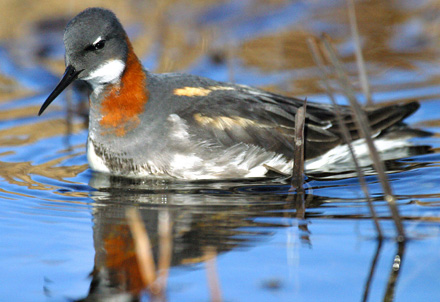| Kingdom: Animalia Phylum: Chordata Class: Aves (Birds) Order: Charadriiformes Family: Scolopacidae Tribe: Tringinae |
 Red-necked Phalarope (Phalaropus lobatus) - female Red-necked Phalarope (Phalaropus lobatus) is a widespread winter visitor in India. This bird is found in the wetlands. Size: 18-19 cm Weight: 35-40 g Identification: Small, long-legged shorebird, often swims, spinning about and picking at the water. Thin, straight, black bill and black legs, dark-centered rump. Thin white stripe in wing. Gray crown and upperparts; black eye patch, white under-parts. From a taxonomic point of view, phalaropes are shorebirds but these shorebirds spend up to 10 months each year at sea, feeding on small zooplankton along oceanic "fronts" (abrupt changes in temperature and/or salinity). Highly visual feeders, phalaropes often spin rapidly in circles to bring prey within easy reach, then use the water surface tension to 'wick' these small prey items from the tip of their bills into their mouths. Unlike the Red Phalarope, which generally nests close to the coast, the Red-necked Phalarope nests along the coast, and several hundred kilometers from the coast, as well as near alpine lakes in the arctic and sub-arctic around the world. In breeding plumage, females are more colorful than males. The more cryptic-colored males provide all incubation and brooding duties for the eggs and precocial young. Although they provide no parental duties, females can mate with multiple males each year, and produce up to four sets of eggs. Jaegers, gulls, and foxes are documented sources of mortality for eggs and adults on the nesting grounds; jaegers, dolphins, storms, and El Nino are documented sources of mortality at sea. Of the three phalaropes species, Red-necked and Red phalaropes are sea-going in the non-breeding season, while Wilson's Phalarope spend the non-breeding season in alkaline lakes in South America. Whereas Red-necked and Red phalaropes are easily distinguished in breeding plumage by the distribution of red plumage, their appearance is rather similar in non-breeding plumage: both sport white heads, bellies & sides, and dark crowns; Red-necked Phalaropes have a more rounded (in cross-section), and more pointed bill. These two species often intermingle in flocks during migration and winter, making identification challenging. Main wintering areas are still rather poorly defined. A majority of the population is thought to winter in upwellings off the west coasts of South America and Africa. This makes the species vulnerable to drastic decreases in prey availability associated with strong El Nino events. |
 birding.in
birding.in
| Birds | Bird Diagram | Ornithology | Indian Sites | Bird Watching | Migration | North India | Birds of India | Haryana |
All rights reserved. Copyright © 2005-2013 Birds and birding in India. Disclaimer
website: Free Java Guide & Tutorials